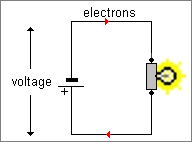|
|
A model for voltage

Voltage is a measure of the energy available to drive a current around an electric circuit. The screen on the left shows a machine that lifts balls to the top of a ramp where they roll down hill and rejoin the conveyor. The conveyor belt represents the battery in a circuit. As each ball moves up the conveyor, it gains potential energy. In an electric circuit, the electrons gain energy as they move through the battery. This gain in energy is the voltage. As the balls run down the ramp, their
potential energy is converted to kinetic energy (and heat energy + sound
energy). The conveyor belt is driven by a petrol fueled motor and it is the chemical energy in the fuel that is converted to the energy of the balls. Once all the fuel is used up the conveyor belt stops and the balls stop moving. The battery also contains a store of chemical energy and this is converted to electrical energy of the electrons. Once this store of energy is used up the electrons stop flowing around the circuit. i.e. the battery is "flat" there is no more energy available to drive the electric current around the circuit. The number of balls remains constant - in the same way the number of electrons remains constant, they are not "used up" as they flow around the circuit. When the battery is flat it is not because it has "run out of electrons", but because it has run out of energy to drive the electrons. |